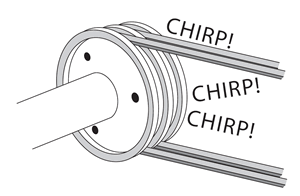 (CHECK UPDATE) Just after we picked up our “New to Us” Coachmen Mirada, it developed a chirping serpentine belt. It wasn’t loud, but it needed to be looked before any long trips as a bad bearing can also cause a chirp.
(CHECK UPDATE) Just after we picked up our “New to Us” Coachmen Mirada, it developed a chirping serpentine belt. It wasn’t loud, but it needed to be looked before any long trips as a bad bearing can also cause a chirp.
As part of bringing all the preventive maintenance up to date and preparation for our long trip, I replaced the serpentine belt with a new Gates belt, and installed new bearings on the two idlers and the tensioner. Replacing the bearing in the idler is substantially cheaper than replacing the entire idler. I also cleaned all the pulleys and idlers with lacquer thinner.
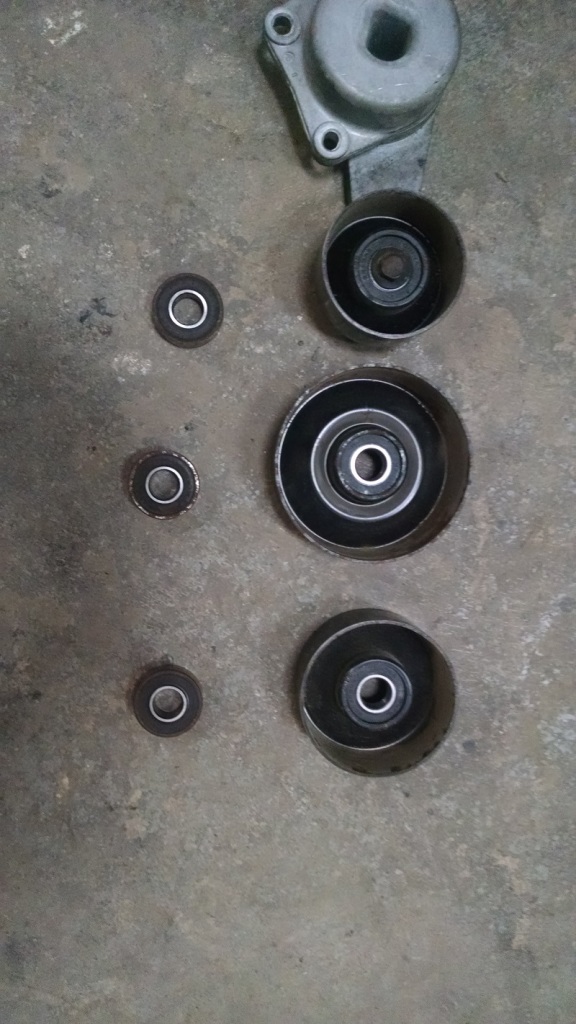
NOTE – This didn’t solve it – fix #1 – CHIRP, CHIRP, CHIRP
When we hit the road, the belt was quiet for the first 100 miles of our trip, then the belt started chirping, then squealing, getting louder, and louder, and louder. It was no long a chirp, but a squeal. and it was loud ……..
Two days of listening to the now obnoxious chirping / squealing, I had a headache and I had enough.
We pulled in and spent a night in one of Oklahoma’s Indian casinos. I popped the doghouse cover and climbed under the MH with a flashlight and a 1/2 inch ratchet. It took me about 5 minutes to remove the new Gates belt. I cleaned all the pulleys with acetone and re-installed the old original belt. (Always carry the old hoses and belts with you as a spare)
When I removed the new Gates belt, it seemed like the tensioner was all the way back to the tensioner springs end stop. ie. the tensioner was at the same position with the belt on or off, so it wasn’t putting a lot (if any) tension on the belt. When I put the old belt back on, the tensioner was about 1/2 way between the two end stops. HHHUUUMM.. If the belt was a little to long, the tensioner would not be able to keep it tight and it would squeal.
NOTE – This didn’t solve it – fix #2 – CHIRP, CHIRP, CHIRP
I re-installed the old original belt and we continued our trip. The old belt chirped a tiny bit, but nowhere near the loud chirp / squeal of the new gates belt.
When we reached Phoenix a couple days later, I decided to stop by the Ford dealer and buy an OEM Motorcraft belt. $80 – OUCH….
NOTE – This didn’t solve it – fix #3 – CHIRP, CHIRP, CHIRP
Back at the RV park, it took about 5 minutes to change the belt and again clean the pulleys. I’m getting real good at this.
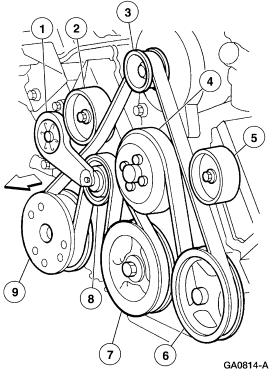 Changing the belt is fairly easy, I started at the top and draped it over the alternator. Make a tiny loop in the belt and push it thru the small opening between the tensioner #8 and the idler #2 from the top. That little loop will pull down and then go around the A/C compressor #9. A helper on top will hold the belt against the alternator (or use a small cloths pin). As the tensioner is pulled back, the belt can be slid over the Power steering pulley (6).
Changing the belt is fairly easy, I started at the top and draped it over the alternator. Make a tiny loop in the belt and push it thru the small opening between the tensioner #8 and the idler #2 from the top. That little loop will pull down and then go around the A/C compressor #9. A helper on top will hold the belt against the alternator (or use a small cloths pin). As the tensioner is pulled back, the belt can be slid over the Power steering pulley (6).
The new OEM belt helped a lot, but there was still a small chirp chirp that could be heard when we were sitting idling.
NOTE – SOLVED – (I hope)
Chirping could be caused by bad bearings, or by the belt sliding slightly sideways or slipping a tiny bit on the pulleys or idlers. The tensioner is designed to hold the belt tight so it doesn’t slip or slide.
3 months later, back at home and now warm enough to work outside, I decided to replace the entire tensioner assembly.
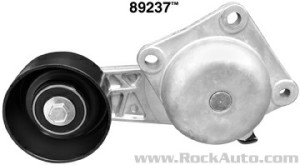
I ordered a new tensioner from Rock Auto for $30.
The tensioner can be reached fairly easily from inside the right wheel well, Before climbing in there, start the engine and turn the steering wheel all the way to the right, this will give you a lot more room to work.
Installation was easy; remove the belt, remove the three bolts, remove the tensioner.
I re-cleaned all the idlers and pulleys, and the flat surface of the belt. When I reinstalled the new OEM belt, I didn’t notice any significant difference in how much UMPH it took to move the tensioner with the breaker bar, but its hard to gauge that when your in cramped quarters.
UPDATE STATUS
We’ve put over 2,000 miles on it since all this. there seems to be a small amount of chirp when the engine is cold, but it barly noticable and goes away after a minute or so when the engine gets warm.
CONCLUSIONS
With all the time I spent screwing around with this, This would be my recommendation to anyone with an older (say 10-12 years) and has a constant chirp.
1) Replace the two idler bearings and clean the wheels.
2) Replace the tensioner. It should have a new idler on it.
3) Clean the groves on the pulleys, I used a small acid brush a lacquer thinner.
4) Install a new belt. be aware of how far the tensioner moves with/without the belt to make sure the tensioner really is putting tension on the belt.
Keep our fingers crossed.

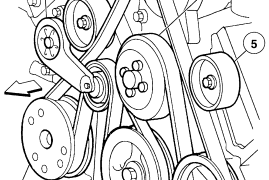
Nice write up. Very helpful. My 1999 Ford F53 chassis with a V10 under a 30′ Southwind coach is totally quiet @ 58,000 miles. Never a peep from the serpentine belt. Off topic but may have value. I’ve owned, driven, and worked on vintage Audis/VWs for 25 years. Whenever I replaced the V belts (3 of them) or the segmented timing belt, if they were too tight they would squeal and/or creak like stuck pigs. If I used after market belts the same. After while I learned, . . . . ONLY use OEM belts made by Continental (German) and adjust them at what seems to be a little loose, tighten later (at about 1,000 miles if necessary) clean all the pulleys/tensioners and, . . . . . . shazam every body is happy! (I know the Ford has an automatic tensioner) The word in the industry was that Continental belts were ever so slightly different in size (cross section) and the rubber compound was better. I think thats why Audi specified them in the first place. (If it works, don’t fix it!) Good luck, I hope you fixed yours for good.
Tom
Thanks you for the followup. Yes, anytime the belts are replaced, you MUST clean the pulleys and idlers. Someone also mentioned on the Ford truck forum that around 2000, Ford had a problem with some OEM tensioners that were slightly misaligned and would chirp. I’m thinking this may have been some of my original problem.